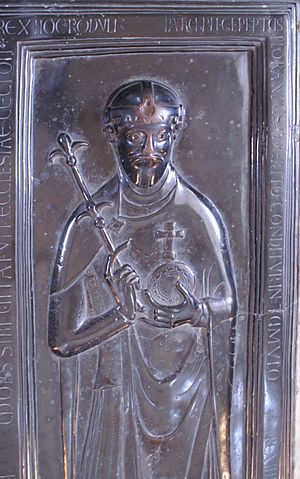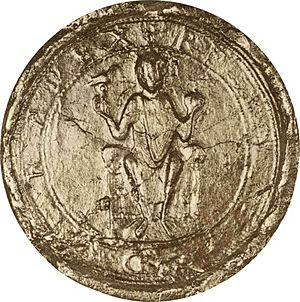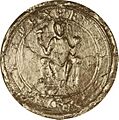Rudolf of Rheinfelden facts for kids
Rudolf of Rheinfelden (born around 1025 – died October 15, 1080) was an important leader in the Holy Roman Empire. He was the Duke of Swabia from 1057 to 1079. Rudolf was first a supporter of Emperor Henry IV, who was his brother-in-law. However, things changed when Rudolf was chosen as a rival king, called an "anti-king," in 1077. This event started a big conflict known as the Great Saxon Revolt and was a key part of the Investiture Controversy. This was a major fight between the Emperor and the Catholic Church. After many battles, Rudolf was badly hurt in the Battle on the Elster, where his forces won against Henry's. He died from his injuries soon after.
Contents
Rudolf's Early Life and Rise to Power
Rudolf was the son of a count named Kuno from Rheinfelden in Swabia. He first appears in historical records in 1048. At that time, he was a count in a region called Sisgau, which is now in Switzerland. Rudolf's family owned a lot of land, stretching from the Black Forest to the Aargau region. His family might have been connected to earlier kings and dukes.
Becoming the Duke of Swabia
In 1057, Duke Otto III of Swabia passed away without any sons. The Empress Agnes, who was the mother of the young King Henry IV, chose Rudolf to become the new Duke of Swabia. He also managed the region of Burgundy.
Rudolf wanted to become even more powerful. According to some stories, he took advantage of King Henry IV being a child. He kidnapped Henry's sister, Matilda of Swabia. Rudolf then demanded to marry Matilda, and he did so in 1059. After Matilda died in 1060, Rudolf married Adelaide of Savoy in 1066. Adelaide was the daughter of Count Otto of Savoy. This marriage made Rudolf Henry IV's brother-in-law twice, because Adelaide's sister, Bertha of Savoy, also married Henry IV in 1066.
Growing Conflict with King Henry IV
During Empress Agnes's time as ruler for her young son, many powerful nobles in the Holy Roman Empire gained more power. They became stronger than the Emperor. In 1062, some nobles even kidnapped the young King Henry IV to gain control of important royal items.
When Henry IV became an adult in 1065, he tried to regain power from the nobles. This led to the Saxon Rebellion in 1073. At first, Rudolf supported Henry's fight against the rebels. He played a big part in the Battle of Langensalza in 1075, where they won.
However, after this victory, Rudolf and King Henry IV started to disagree. There were rumors that Rudolf was involved in plans against the king. Empress Agnes often had to help them settle their arguments.
The Investiture Controversy and Rudolf as Anti-King
A major conflict called the Investiture Controversy began. This was a disagreement over who had the right to appoint church leaders – the Emperor or the Pope. In February 1076, Pope Gregory VII removed King Henry IV from the church (this is called "excommunication").
After this, Duke Rudolf met with other powerful nobles to decide what to do. They planned to choose a new king. Henry IV realized he was losing support and had to get the Pope to lift his excommunication.
The Walk to Canossa
In January 1077, Henry IV traveled through harsh winter weather to meet the Pope. This journey is known as the "Walk to Canossa." Rudolf tried to block the mountain passes to stop Henry, but he failed. Henry reached Pope Gregory, who was staying with Matilda of Tuscany. By showing he was sorry, Henry convinced the Pope to forgive him. This bought Henry some time, but it also made him look weaker.
Rudolf is Chosen as Anti-King
Even though Henry was forgiven, the rebel nobles continued their plans. On March 15, 1077, Rudolf was chosen as the "anti-king" at a meeting in Forchheim. This meant he was a rival king to Henry IV. Rudolf was the first anti-king in the history of the Holy Roman Empire. He promised to respect church rules for appointing leaders and to support the idea that kings should be chosen by nobles, not just inherit their power.
Rudolf then went to Mainz, where he was crowned king on May 25. However, the people of Mainz rebelled, and Rudolf had to escape to Saxony. This created a problem because Saxony was far from his home region of Swabia, with Henry's lands in between. The Pope also did not immediately take sides. Henry's supporters accused Rudolf of being greedy and a traitor. Rudolf's own support began to weaken.
Later Life and Final Battle
Rudolf gave the Duchy of Swabia to his son Berthold. He tried to fight Henry's forces near Würzburg, but it didn't help much. In May, Henry's supporters officially took Swabia away from Rudolf. King Henry then gave the duchy to Frederick of Stauf, who was the first ruler from the House of Hohenstaufen.
In 1078, Henry had a successful military campaign in Bavaria. The Pope still refused to excommunicate Rudolf. The Battle of Mellrichstadt in August 1078 ended without a clear winner. Rudolf found it hard to convince the Saxons to fight outside their own lands. They saw him as a southerner and didn't fully trust him. He was also frustrated that the Pope seemed unwilling to fully support him. To keep his followers, Rudolf had to give away large parts of royal and church lands.
However, things seemed to get better for Rudolf in 1080. The battle of Flarchheim in January 1080 was a victory for him. On March 7, the Pope excommunicated Henry again and recognized Rudolf as the rightful king.
The Battle of Elster and Rudolf's Death
Encouraged by the Pope's support, Rudolf's forces met Henry's army at the White Elster river. This battle, known as the Battle of Elster, took place on October 14, 1080. It was a big victory for Rudolf's side.
However, during the battle, Rudolf lost his right hand and was badly wounded in his stomach. He was taken to nearby Merseburg, where he died the next day. Rudolf was buried in Merseburg Cathedral. After his death, much of the support for the rebellion against Henry IV disappeared. The conflict continued for a few more years, but Rudolf's death was a major turning point.
Rudolf's Children
With his second wife, Adelaide, Rudolf had at least four children:
- Agnes of Rheinfelden, who married Berthold II of Zähringen.
- Adelaide of Rheinfelden, who married King Ladislaus I of Hungary.
- Bertha of Rheinfelden, who married Ulrich X, Count of Bregenz.
- Otto, who died when he was young.
- Berthold of Rheinfelden (there is some debate about who Berthold's mother was).
Images for kids
|
Rudolf of Rheinfelden
Born: c. 1025 Died: 15 October 1080 |
||
| Preceded by Otto III |
Duke of Swabia 1057–1079 |
Succeeded by Berthold I |
See also
In Spanish: Rodolfo de Rheinfelden para niños





